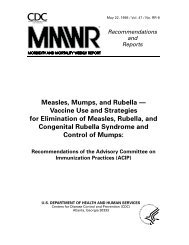Writing Scientific Manuscripts Presentation - The INCLEN Trust
Writing Scientific Manuscripts Presentation - The INCLEN Trust
Writing Scientific Manuscripts Presentation - The INCLEN Trust
You also want an ePaper? Increase the reach of your titles
YUMPU automatically turns print PDFs into web optimized ePapers that Google loves.
<strong>Writing</strong> <strong>Scientific</strong> <strong>Manuscripts</strong>a guide for undergraduatesCopyright 2005, Journal of YoungInvestigators, Inc.
Table of Contents• Introduction• Part I: Publication & Peer Review– Deciding to Publish– Submitting Your Paper– After Submission– Overview of Peer Review– Purpose of Peer Review– How It Works– <strong>The</strong> Role of Editor– Limitations and IssuesCopyright 2005, Journal of YoungInvestigators, Inc.
Table of Contents Cont’d• Part II: <strong>Writing</strong> a <strong>Scientific</strong> Manuscript– <strong>The</strong> <strong>Scientific</strong> Manuscript– Word Choice– <strong>The</strong> Abstract– <strong>The</strong> Introduction– <strong>The</strong> Methods & Materials Section– <strong>The</strong> Results Section– <strong>The</strong> Discussion Section– Figures, Tables, Equations, and ReferencesCopyright 2005, Journal of YoungInvestigators, Inc.
IntroductionWelcome to JYI’s Guide to Reporting <strong>Scientific</strong>Research! This is a free presentation (based offthe guidebook), written and distributed by theJournal of Young Investigators, an internationalscience research journal run entirely byundergraduates, for undergraduates.Copyright 2005, Journal of YoungInvestigators, Inc.
Part I: Publication & PeerReview:Copyright 2005, Journal of YoungInvestigators, Inc.
Deciding to Publish andSubmitting Your Paper• What to publish?– abstract vs. full report• Choosing your forum– Which type of journal is best for you?– What audience are you targeting?– (<strong>The</strong> JYI advantage!)• Research the journal– Publication guidelines– Article styleCopyright 2005, Journal of YoungInvestigators, Inc.
After Submission• Publication Procedure (6-12 months)– Author submits– Editor is assigned to manuscript– Editor assigns reviewers (associate editors) to inspect– Reviewers decide on whether to review paper– Several reviewers inspect and edit– Editor decides on accuracy of revisions and whether to acceptpaper– If accepted, editor sends paper back to author with revisions– Author revises paper and sends it back– Possibility of second review process– Publication!Copyright 2005, Journal of YoungInvestigators, Inc.
What is Peer Review?• Review process for scientists by scientists• Purpose– To filter what is published as “science”– To provide researchers with perspective• Where is peer review used?– <strong>Scientific</strong> publication– Grant review– Tenure promotionCopyright 2005, Journal of YoungInvestigators, Inc.
Constraints of Peer Review• Slow• Conflicting views– Confronting theory bias• Personal views– Objective vs. personal edits• Fraud– Data manipulation andinvention“Editors and scientists portraypeer review as a quasi-sacredprocess that helps to makescience our most objective truthteller. But we know that the systemof peer review is biased, unjust,unaccountable, incomplete, easilyfixed, often insulting, usuallyignorant, occasionally foolish, andfrequently wrong.”-- Richard Horton, editor of <strong>The</strong>Lancet,Copyright 2005, Journal of YoungInvestigators, Inc.
<strong>Scientific</strong> Misconduct• Gift Authorship• Redundant Publication• Plagiarism• Fabrication• Falsification• Conflict of InterestCopyright 2005, Journal of YoungInvestigators, Inc.
Part II: <strong>Writing</strong> a <strong>Scientific</strong>ManuscriptCopyright 2005, Journal of YoungInvestigators, Inc.
<strong>Writing</strong> Style and Audience• Checklist:• Void of anecdotes or stories• Reports facts not outlandish conclusions• No misspellings• Grammatical accuracy• Meets formatting guidelines• Avoids using the first person• Who’s the audience?• Write for your target audienceCopyright 2005, Journal of YoungInvestigators, Inc.
Word Choice• Examine vs. Analyze– Activity to gain knowledge vs. Describing the analysisof that knowledge• Bloom’s Taxonomy– Knowledge– Comprehension– Application– Analysis– Synthesis– EvaluationCopyright 2005, Journal of YoungInvestigators, Inc.
• Bloom’s TaxonomyWord Choice– Knowledge: Recitation of fact• Found, identified, labeled– Comprehension: State a problem or interpret fact• Discuss, predict, compare– Application: Apply old information to solve new problems• Solve, show, examine, classify– Analysis: Used to explain patterns or meaning• Analyze, investigate, compare, contrast– Synthesis: Making predictions or discussing possibilities• Predict, plan, devise, propose– Evaluation: Drawing conclusions, making recommendations• Justify, verify, argue, recommend, determineCopyright 2005, Journal of YoungInvestigators, Inc.
Manuscript Structure• Abstract• Introduction• Body of Article• Results• Discussion and Conclusions• Acknowledgements• References• Figures and TablesCopyright 2005, Journal of YoungInvestigators, Inc.
Abstract• Summary of Manuscript (200-300 Words)• Problem investigated• Purpose of Research• Methods• Results• ConclusionCopyright 2005, Journal of YoungInvestigators, Inc.
Abstract• Common Mistakes– Too much background or methods information– Figures or images– References to other literature, figures or images– Abbreviations or acronymsCopyright 2005, Journal of YoungInvestigators, Inc.
Introduction• Broad information on topic– Previous research• Narrower background information– Need for study• Focus of paper– Hypothesis• Summary of problem (selling point)• Overall 300-500 wordsCopyright 2005, Journal of YoungInvestigators, Inc.
Introduction• Common Mistakes– Too much or not enough information– Unclear purpose– Lists– Confusing structure– First-Person anecdotesCopyright 2005, Journal of YoungInvestigators, Inc.
Methods and Materials• Provides instruction on exactly how torepeat experiment– Subjects– Sample preparation techniques– Sample origins– Field site description– Data collection protocol– Data analysis techniques– Any computer programs used– Description of equipment and its useCopyright 2005, Journal of YoungInvestigators, Inc.
Methods and Materials• Common Mistakes– Too little information– Information from Introduction– Verbosity– Results/ sources of error reportedCopyright 2005, Journal of YoungInvestigators, Inc.
Results• Objective presentation of experimentresults– Summary of data• NOT a Discussion!Copyright 2005, Journal of YoungInvestigators, Inc.
Results• Common mistakes– Raw data– Redundancy– Discussion and interpretation of data– No figures or tables– Methods/materials reportedCopyright 2005, Journal of YoungInvestigators, Inc.
Discussion• Interpret results– Did the study confirm/deny the hypothesis?– If not, did the results provide an alternative hypothesis?What interpretation can be made?– Do results agree with other research? Sources oferror/anomalous data?– Implications of study for field– Suggestions for improvement and future research?• Relate to previous researchCopyright 2005, Journal of YoungInvestigators, Inc.
Discussion• Common Mistakes– Combined with Results– New results discussed– Broad statements– Incorrectly discussing inconclusive results– Ambiguous data sources– Missing informationCopyright 2005, Journal of YoungInvestigators, Inc.
Figures and Tables• Tables– Presents lists of numbers/ text in columns• Figures– Visual representation of results or illustration ofconcepts/methods (graphs, images, diagrams, etc.)• Captions– Must be stand-aloneCopyright 2005, Journal of YoungInvestigators, Inc.
Figures and Tables• Guidelines for Figures and Tables– High resolution– Neat, legible labels– Simple– Clearly formatted– Indicate error– Detailed captionsCopyright 2005, Journal of YoungInvestigators, Inc.
References• Check specific referencing style of journal• Should reference:– Peer-reviewed journal articles, abstracts,books• Should not reference:– Non-peer-reviewed works, textbooks,personal communicationsCopyright 2005, Journal of YoungInvestigators, Inc.
References• Common Mistakes– Format, Format, Format• (Figures & Tables, Equations, and References)– Redundant Information• Text, Figures, Tables, and Captions– Type of ReferenceCopyright 2005, Journal of YoungInvestigators, Inc.
Journal of Young Investigatorswww.jyi.orgCopyright 2005, Journal of YoungInvestigators, Inc.

















